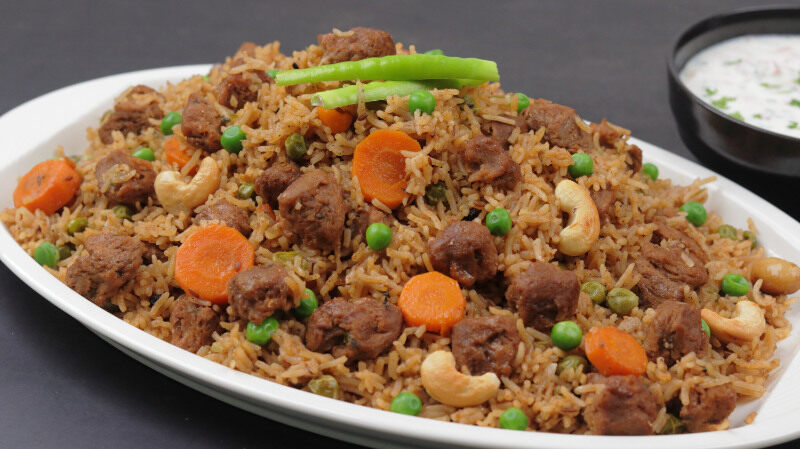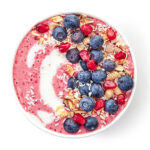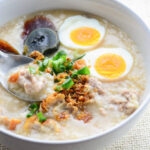Soya chunks carrot pulao is a delicious and nutritious dish made with soya chunks (textured vegetable protein), rice, carrots, and various spices. It’s a popular vegetarian recipe that’s both filling and flavorful. Here’s a basic recipe to make soya chunks carrot pulao:
| Ingredients | |
| 1 | 1 cup basmati rice (or any long-grain rice), soaked for 30 minutes and drained |
| 2 | 1 cup soya chunks (textured vegetable protein), soaked in hot water for 15-20 minutes and then drained |
| 3 | 1 large carrot, peeled and diced |
| 4 | 1 large onion, thinly sliced |
| 5 | 2-3 green chilies, slit lengthwise (adjust to taste) |
| 6 | 2-3 cloves garlic, minced |
| 7 | 1-inch piece of ginger, minced |
| 8 | 2-3 tablespoons cooking oil or ghee (clarified butter) |
| 9 | 1 teaspoon cumin seeds |
| 10 | 2-3 green cardamom pods |
| 11 | 2-3 cloves |
| 12 | 1-inch cinnamon stick |
| 13 | Salt to taste |
| 14 | 2 cups water |
| 15 | Fresh cilantro leaves for garnish (optional) |
| 16 | Spice Mix (adjust to taste): |
| 17 | 1 teaspoon turmeric powder |
| 18 | 1 teaspoon cumin powder |
| 19 | 1 teaspoon coriander powder |
| 20 | 1/2 teaspoon red chili powder (adjust to taste) |
Step-by-step cooking instruction of Soya Chunks Carrot Pulao:
Step-1 In a big pan or saucepan, heat the oil or ghee over medium heat. Stir in the cinnamon stick, cloves, green cardamom pods, and cumin seeds. Sauté for a minute until fragrant.
Step-2 Add sliced onions and sauté until they turn golden brown.
Step-3 Add minced garlic, ginger, and slit green chilies. Sauté for another minute.
Step-4 Add diced carrots and soaked soya chunks. Stir continuously and cook for 2 to 3 minutes.
Step-5 Add the spice mix – turmeric powder, cumin powder, coriander powder, and red chili powder. Stir well to roast the spices, then simmer for one minute.
Step-6 Add drained rice to the pot and mix gently with the vegetables and spices.
Step-7 Pour in 2 cups of water and season with salt according to taste. Bring the mixture to a boil.
Step-8 Once it starts boiling, reduce the heat to low, cover the pot with a lid, and let it simmer for about 15-20 minutes, or until the rice is cooked and the water is absorbed.
Step-9 Once the rice is cooked, turn off the heat and let it sit covered for another 5-10 minutes.
Step-10 Fluff the rice gently with a fork. Garnish with fresh cilantro leaves if desired.
Step-11 Serve hot with raita (yogurt dip) or any side of your choice.
Nutritional values of Soya Chunks Carrot Pulao:
Here’s a basic overview of the nutritional value of soya chunks carrot pulao per serving, based on a typical recipe:
Nutrition Information (per serving, approximate values):
| 1 | Calories: Around 300-350 kcal |
| 2 | Protein: Approximately 10-15 grams |
| 3 | Fat: Around 5-10 grams (varies based on cooking method and added fats/oils) |
| 4 | Carbohydrates: Approximately 50-60 grams |
| 5 | Dietary Fiber: 5-8 grams |
| 6 | Vitamins and Minerals: |
| Vitamin A from carrots: contributes to eye health and immune function | |
| Vitamin C from carrots and spices: acts as an antioxidant and supports immune health | |
| Vitamin B6 from spices: aids in metabolism and nervous system function | |
| Iron from soya chunks: important for oxygen transport in the blood | |
| Calcium from soya chunks: essential for bone health | |
| Potassium from carrots: helps regulate blood pressure and muscle function |
Background History of Soya Chunks Carrot Pulao
The background history of a specific dish like soya chunks carrot pulao may not be extensively documented, as it’s a modern fusion recipe that likely emerged with the popularity of vegetarian and vegan cuisine, particularly in regions where dishes like pulao (a rice dish cooked with vegetables and spices) are common.
Here’s a general overview of the components and their histories:
Soya Chunks (Textured Vegetable Protein):
Soybeans have been cultivated for thousands of years, primarily in East Asia. Soy-based foods like tofu, tempeh, and soy milk have been staples in Asian cuisines for centuries.
Textured vegetable protein, or TVP, which is derived from soy flour, gained popularity in the mid-20th century as a meat substitute, particularly in vegetarian and vegan diets.
Soya chunks, a form of TVP, have become popular in Indian cuisine as a protein-rich ingredient in various dishes, including curries, biryanis, and pulao.
Carrots:
Carrots have been grown for thousands of years, with its origins thought to be in Central Asia.
They were initially grown for their medicinal properties before becoming a widely consumed vegetable in cuisines around the world.
Carrots are commonly used in Indian cooking, adding sweetness and color to dishes like pulao.
Pulao:
Pulao, also known as pilaf or pilau, is a rice dish that originated in the Middle East.
It spread to Central Asia and South Asia through trade routes and migrations, where it became a popular dish with regional variations.
Pulao typically consists of rice cooked with spices, vegetables, and sometimes meat or seafood, depending on the region and dietary preferences.
The fusion of soya chunks, carrots, and pulao likely emerged as a way to incorporate protein-rich vegetarian ingredients into traditional rice dishes. This fusion reflects the evolution of cuisines over time, as people adapt recipes to suit changing tastes, dietary preferences, and ingredient availability.
| Advantages of Soya Chunks Carrot Pulao | |
| 1 | Nutritional Benefits: This recipe is a wonderful source of vegetarian protein because soya chunks are high in protein. Vitamins and Minerals: Carrots provide essential vitamins such as vitamin A and minerals like potassium. Fiber: Both soya chunks and carrots contain dietary fiber, which aids in digestion and promotes a feeling of fullness. |
| 2 | Vegetarian/Vegan Option: Soya chunks carrot pulao is a flavorful vegetarian or vegan option, suitable for those who avoid meat or animal products. |
| 3 | Easy to Make: Pulao dishes are generally straightforward to prepare, making this recipe accessible for home cooks of varying skill levels. |
| 4 | Versatility: This dish can be customized with additional vegetables, spices, or herbs according to personal taste preferences. |
| 5 | Budget-Friendly: Soya chunks and carrots are relatively inexpensive ingredients, making this dish a cost-effective meal option, especially for larger families or gatherings. |
| Balanced Meal: Soya chunks carrot pulao combines carbohydrates from rice, protein from soya chunks, and vitamins and minerals from carrots, offering a balanced and nutritious meal in one dish. |
| Disadvantages of Soya Chunks Carrot Pulao | |
| 1 | Allergy Concerns: Some individuals may have allergies to soy products, so they need to be cautious when consuming dishes containing soya chunks. Additionally, while rare, carrot allergies exist, so individuals with known carrot allergies should avoid this dish. |
| 2 | Anti-Nutrients in Soya: Soya contains compounds such as phytates and trypsin inhibitors, which can inhibit the absorption of certain nutrients like iron and protein if not properly prepared. Soaking and cooking soya chunks adequately can help mitigate these anti-nutrients. |
| 3 | Soy Sensitivity: Some people may experience digestive discomfort or allergic reactions to soy products, so they should consume soya chunks carrot pulao in moderation or avoid it altogether if they have sensitivities. |
| 4 | Caloric Content: Depending on portion size and added fats/oils during cooking, soya chunks carrot pulao can be relatively high in calories, especially if large amounts of oil or ghee are used. |
| 5 | Potential Overcooking: Overcooking the soya chunks or carrots can result in a mushy texture, detracting from the overall appeal of the dish. |
| 6 | Cultural Preferences: While pulao dishes are popular in many cultures, some individuals may prefer traditional versions without the addition of soya chunks, viewing it as an unnecessary modification. |
Compare with Similar meal of Soya Chunks Carrot Pulao:
Similar meals to soya chunks carrot pulao include other rice-based dishes that incorporate soya chunks and vegetables. Here are a few examples:
| 1 | Soya Chunks Vegetable Biryani: Biryani is a fragrant rice dish cooked with spices, meat, or vegetables. Soya chunks can be substituted for meat to create a vegetarian version. This dish typically includes a variety of vegetables along with aromatic spices like cardamom, cinnamon, and cloves. |
| 2 | Soya Chunks Fried Rice: Fried rice is a versatile dish made by stir-frying cooked rice with vegetables, protein, and seasonings. Soya chunks can be added to fried rice along with carrots, peas, bell peppers, and other vegetables, creating a protein-packed and flavorful meal. |
| 3 | Soya Chunks Curry with Rice: This dish features soya chunks cooked in a flavorful curry sauce served over rice. The curry can be made with tomatoes, onions, garlic, ginger, and spices like turmeric, cumin, and coriander. Carrots and other vegetables can be added to enhance the nutritional content. |
| 4 | Soya Chunks Pulao with Mixed Vegetables: Similar to soya chunks carrot pulao, this dish includes a mix of soya chunks and various vegetables such as peas, beans, cauliflower, and bell peppers. The rice is cooked with aromatic spices and vegetables, creating a colorful and nutritious one-pot meal. |
| 5 | Soya Chunks Stir-Fry with Rice Noodles: Rice noodles stir-fried with soya chunks, carrots, cabbage, and other vegetables make for a quick and satisfying meal. A flavorful sauce made with soy sauce, ginger, garlic, and chili paste adds depth of flavor to the dish. |
| 6 | Soya Chunks and Vegetable Pilaf: Pilaf, similar to pulao, is a rice dish cooked with broth and seasoned with spices. Soya chunks and carrots can be added to the pilaf along with other vegetables such as peas, corn, and green beans. The dish is typically cooked until the rice is fluffy and infused with the flavors of the vegetables and spices. |
Mostly questions asked about Soya Chunks Carrot Pulao
1: What is soya chunks carrot pulao?
A: Soya chunks carrot pulao is a flavorful rice dish made with soya chunks (textured vegetable protein), carrots, rice, and a blend of spices. It’s a popular vegetarian recipe that combines protein-rich soya chunks with the sweetness of carrots and the aromatic flavors of spices.
2: How do you cook soya chunks for pulao?
A: Soya chunks are typically soaked in hot water for 15-20 minutes to rehydrate them before cooking. After soaking, drain the water and squeeze out any excess moisture from the soya chunks. They can then be added directly to the pulao along with other ingredients for cooking.
3: Can I use other vegetables besides carrots in soya chunks pulao?
A: Yes, you can customize the dish by adding other vegetables such as peas, bell peppers, beans, cauliflower, or corn. Feel free to use your favorite vegetables or whatever you have on hand to create a colorful and nutritious pulao.
4: Is soya chunks carrot pulao suitable for vegans?
A: Yes, soya chunks carrot pulao is a vegan dish as it does not contain any animal products. It’s a flavorful and satisfying option for individuals following a vegan diet.
5: What spices are typically used in soya chunks carrot pulao?
A: Common spices used in soya chunks carrot pulao include cumin seeds, cardamom pods, cloves, cinnamon, turmeric powder, cumin powder, coriander powder, and red chili powder. These spices add depth of flavor and aroma to the dish.
6: Can I make soya chunks carrot pulao in a pressure cooker?
A: Yes, soya chunks carrot pulao can be cooked in a pressure cooker for a quicker cooking time. Simply follow the same steps for sautéing the ingredients, add rice, water, and soaked soya chunks, then pressure cook for the appropriate time according to your pressure cooker’s instructions.
7: Is soya chunks carrot pulao gluten-free?
A: Yes, soya chunks carrot pulao is typically gluten-free as long as all the ingredients used are gluten-free. Rice, soya chunks, carrots, and commonly used spices are naturally gluten-free, making this dish suitable for those with gluten sensitivities or celiac disease.
8: How can I make soya chunks carrot pulao healthier?
A: To make the dish healthier, you can use brown rice instead of white rice for added fiber and nutrients. You can also reduce the amount of oil or ghee used for cooking and adds more vegetables to increase the nutritional content.
9: Can I make soya chunks carrot pulao ahead of time?
A: Yes, you can make soya chunks carrot pulao ahead of time and store it in an airtight container in the refrigerator for up to 2-3 days. Before serving, just give it a quick reheat in the microwave or on the stove.
10: What can I serve with soya chunks carrot pulao?
A: Soya chunks carrot pulao can be served with various accompaniments such as raita (yogurt dip), cucumber salad, mango pickle, or any other side dish of your choice. These accompaniments complement the flavors of the pulao and enhance the overall meal experience.







